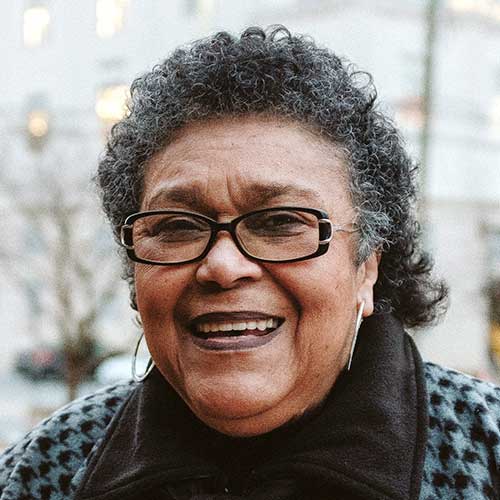1973
1973
Bulldozers move in on Garrett; residents move out
Description
- Using urban renewal, the city begins bulldozing the 184 buildings in the Garrett Street area—more than 80 percent of which are residential.
- The Charlottesville Redevelopment and Housing Authority declares the neighborhood “blighted,” appraising every property, ultimately valuing them at a total of $2.13 million.
- The residential housing stock in the area is a mix of owner-occupied homes and rentals. A majority of residents are African-American and working-class, but some white families live here as well.
- Laura. M. Dowell, an African-American, lives at 509 Ware St., a two-story home on a street situated where Friendship Court is today.
- Edward J. Henderson, an African-American, owns 211-213 Diggs St., which was divided into two apartments. He rents them for $60/month, affordable for working-class residents at the time.
- Homeowners are mostly paid the appraised value for their homes, sometimes more. Some renters receive $1,500 to make a down payment on a new home, while others get lump sums to pay rent in other parts of town.
- Marguiretta’s House, the city’s most infamous brothel, is torn down.
Quote
The structure is divided vertically into two units, each of which has living room, kitchen and full bath on the first floor and one bedroom on the second floor. Rent is $15.00 per week unfurnished for each unit.
— CRHA assessment document
People
What do you remember about Miss Marguiretta’s house?
The Reimagining of Friendship Court
INTRO
By
Jordy Yager
The redevelopment of Friendship Court is slated to be the largest new construction of low-income housing undertaken in Charlottesville in more than two decades. The plan alone is groundbreaking, having been directly created by current Section 8 residents in partnership with Piedmont Housing Alliance. City staff calls it the most nuanced and complex plan they’ve ever encountered. It ambitiously attempts to balance promises of zero resident displacement with the city’s broader affordable housing needs, while also calling for hundreds of new, likely higher-income, residents to move in, as residents hope to de-stigmatize the lasting effects of poverty born out of generations of racist government policy and neglect.
This year will be the make-or-break year for Friendship Court’s redevelopment efforts. Millions of dollars in city, federal, and private funding stand between the massive plan and the highly anticipated 2020 groundbreaking. And while the green lights have begun to align and most residents are excited, the plan has its critics — those who call for greater levels of resident autonomy, greater security measures to guard against social and cultural displacement, and greater reparations for past wrongs.
In crafting this project, we’ve tried to tackle all of this and more by separating the longer narratives into five major questions:
Part 1: What is the plan?
Part 2: How did we get here?
Part 3: Does mixed-income housing work?
Part 4: Who does Friendship Court belong to?
Part 5: What’s next?
But we also wanted to give you access to as much of our reporting as possible, so we’ve created a timeline that details the history of this area, dating back 150 years, through the use of more than 130 maps, documents, archived articles, and photographs. Similarly, we wanted you to actually hear each of the two dozen long-form interviews we conducted, and not merely the portions we’ve included in the individual stories. So we’ve included more than 300 audio clips throughout the story: in the articles, the timeline, and on each person’s profile page. Our hope is that with all this, more of the picture will begin to emerge, and that, as we stand ready to make powerful and significant changes in the city, we all can help craft the solutions.
The redevelopment of Friendship Court is slated to be the largest new construction of low-income housing undertaken in Charlottesville in more than two decades. The plan alone is groundbreaking, having been directly created by current Section 8 residents in partnership with Piedmont Housing Alliance. City staff calls it the most nuanced and complex plan they’ve ever encountered. It ambitiously attempts to balance promises of zero resident displacement with the city’s broader affordable housing needs, while also calling for hundreds of new, likely higher-income, residents to move in, as residents hope to de-stigmatize the lasting effects of poverty born out of generations of racist government policy and neglect.
This year will be the make-or-break year for Friendship Court’s redevelopment efforts. Millions of dollars in city, federal, and private funding stand between the massive plan and the highly anticipated 2020 groundbreaking. And while the green lights have begun to align and most residents are excited, the plan has its critics — those who call for greater levels of resident autonomy, greater security measures to guard against social and cultural displacement, and greater reparations for past wrongs.
In crafting this project, we’ve tried to tackle all of this and more by separating the longer narratives into five major questions:
Part 1: What is the plan?
Part 2: How did we get here?
Part 3: Does mixed-income housing work?
Part 4: Who does Friendship Court belong to?
Part 5: What’s next?
But we also wanted to give you access to as much of our reporting as possible, so we’ve created a timeline that details the history of this area, dating back 150 years, through the use of more than 130 maps, documents, archived articles, and photographs. Similarly, we wanted you to actually hear each of the two dozen long-form interviews we conducted, and not merely the portions we’ve included in the individual stories. So we’ve included more than 300 audio clips throughout the story: in the articles, the timeline, and on each person’s profile page. Our hope is that with all this, more of the picture will begin to emerge, and that, as we stand ready to make powerful and significant changes in the city, we all can help craft the solutions.





